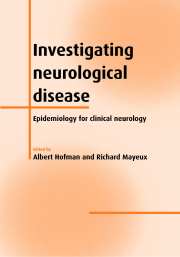Book contents
- Frontmatter
- Contents
- List of contributors
- Preface
- Part I Quantitative methods in clinical neurology
- Part II Neurological diseases
- 10 Cerebrovascular ischemic disease
- 11 Vascular dementia
- 12 Alzheimer's disease
- 13 Parkinson's disease
- 14 Multiple sclerosis
- 15 Myasthenia gravis
- 16 Guillain–Barré syndrome
- 17 Encephalitis and meningitis
- 18 HIV infection
- 19 Prion diseases
- 20 Neoplastic disease
- 21 Cerebral palsy
- 22 Migraine
- Index
15 - Myasthenia gravis
from Part II - Neurological diseases
Published online by Cambridge University Press: 29 September 2009
- Frontmatter
- Contents
- List of contributors
- Preface
- Part I Quantitative methods in clinical neurology
- Part II Neurological diseases
- 10 Cerebrovascular ischemic disease
- 11 Vascular dementia
- 12 Alzheimer's disease
- 13 Parkinson's disease
- 14 Multiple sclerosis
- 15 Myasthenia gravis
- 16 Guillain–Barré syndrome
- 17 Encephalitis and meningitis
- 18 HIV infection
- 19 Prion diseases
- 20 Neoplastic disease
- 21 Cerebral palsy
- 22 Migraine
- Index
Summary
Myasthenia gravis (MG) is characterized by fluctuating weakness of striated muscles and is due to a neuromuscular transmission defect secondary to an autoimmune response toward the acetylcholine receptors (AchR) at the neuromuscular junction (NMJ). It is a heterogeneous disorder that can be classified upon the age at onset: as pediatric or adult forms (10% and 90%, respectively), or upon the distribution of the muscles involved, as suggested by Osserman. The milder form is localized ocular myasthenia (I), that may progress within 1–2 years to generalized myasthenia that can be mild (IIA), moderately severe (IIB), acute fulminating with bulbar involvement (III) or late severe MG (IV) (2,3). Involvement of bulbar function may lead to acute respiratory failure which is the hallmark of myasthenic crisis and is still life-threatening. MG is a rare disease, even though its incidence and prevalence rates are growing: for example, its prevalence was 7.8–14.2 per 100,000 population in the 1970s and 1980s while it was 2.5–6.4 per 100,000 in the 1960s. These increases are probably due to improvement in the diagnosis and longer survival of patients requiring respiratory care (4,8–10). Its case-fatality rate is 2–4%. MG is associated with other autoimmune diseases in 9–14% of the cases; as in such disease, it has a bimodal age at onset, especially in women, at the 3rd–4th and at the 8th decade (14,15).
Etiology
It is the pathogenesis rather than the etiology of MG that has been established.
- Type
- Chapter
- Information
- Investigating Neurological DiseaseEpidemiology for Clinical Neurology, pp. 205 - 217Publisher: Cambridge University PressPrint publication year: 2001

